Largest optical telescopes of the world
By Paul Schlyter, Stockholm, Sweden
email: pausch@stjarnhimlen.se
WWW: http://stjarnhimlen.se/
Break out of a frame
2003-10-10 First version
2003-12-27 Updated
2004-01-06 Additional info about Herchel's 1.22 m reflector
2005-07-14 Info about future large telescopes updated
2005-11-03 LBT is now operational and I've put it as the world's largest scope here,
although it becomes somewhat ambiguous with binocular scopes.
SALT is delayed by about half a year.
2006-04-20 TMT added, details added in historical list, Rascine's reference added.
Thanks Alan Tokunaga for this info!
2006-07-11 Great Melbourne Telescope added, replacing some other "largest scopes"
from that time. Thanks Barry Clark for pointing this out.
2006-10-10 Added Hans Lippershey at the beginning of the list. Thanks Peter Kremer
for pointing this out
2008-09-05 Added some more interesting telescopes, and also a short overview of
non-optical telescopes.
2009-10-18 Added a pre-Lippershey "telescopic device" with a mirror eyepiece!
2009-10-31 Added some additional info about Herschel's telescopes.
2009-11-02 Added Berlin's big refractor - thanks astronomiguiden.se
2011-12-09 Added info about E-ELT, updated info about telescopes not yet operational.
2011-12-10 Added links to telescope lists at Wikipedia.
2021-10-07 Updated expected opening dates of large telescopes under construction.
Below is a list of the largest optical astronomical telescopes of the
world at various times, from the invention of the telescope in 1609
up to the present day. The list is believed to be fairly complete,
but for earlier years there may still be some errors. If anyone has
any additions or corrections to this list, please email me!
World's
largest Aperture Scope
scope in meters
1580 ? William Bourne's telescopic device with a lens as objective and a
concave mirror as eyepiece! Didn't understand how it worked,
believed magnification depends on the diameter of the lens.
1608 ? Hans Lippershey, inventor of the telescope.
1609 0.016 Galileo - first person to properly observe the skies with a telescope.
1612 0.026 Galileo.
1620 0.038 Galileo.
1638 0.06 Hevelius - Scheiner's helioscope - the first equatorially mounted scope.
1645 0.12 Hevelius, Danzig.
1655 0.057 Christian Huygens 12 foot f.l. refractor; discovered Titan.
1656 0.07 Christian Huygens 23 foot f.l. refractor, x100.
1672 0.10 Newton (reflector).
1675 0.13 Hooke (reflector).
1680? 0.18 Robert Hooke's Gregorian reflector.
1686 0.19 Constantin Huygens 7.5" 123 foot f.l. air telescope.
1686 0.20 Constantin Huygens 8" 170 foot f.l. air telescope.
1686 0.22 Constantin Huygens 8.5" 210 foot f.l. air telescope.
1690 0.20 Cassini.
1721 0.15 Halley (reflector).
1734 0.38 Gregorian reflector by James Short.
1750 0.50 Gregorian reflector by James Short.
1752 0.46 Gregorian reflector by James Short, made for the king of Spain.
1761 0.60 Father Noel (reflector).
1780-1789 0.75 Rev J. Mitchell's Gregorian reflector,
bought, although broken, by Willian Herschel after Mitchell's death.
1789-1815 1.22 William Herschel's 40 foot f.l. reflector, Bath, England.
Last used in 1815, destroyed in a gale 1839. Frame dismantled by
John Herschel 1840 due to rot, then the tube lay in the garden and was
crushed by a falling tree in 1870. Today the original mirror and a
quarter of the tube remains.
1815-1826 0.47 William Herschel's 20 foot f.l. reflector, Bath, England, built in 1783.
Restored by William and John Herschel in 1820, then used by
John Herschel in South Africa 1834-1838.
1826-1845 0.91 Lord Rosse's first reflector with 3 foot aperture.
1845-1878 1.83 Lord Rosse's Leviathan, 6 foot aperture, Birr Castle, Ireland.
Last used in 1878, deteriorated rapidly from 1908, dismantled in 1914,
mirror moved to Science Museum. Restored in 1998 with a mirror of
aluminium. One of the original mirror remains at Science Museum,
the second original mirror is lost.
1878-1889 1.22 Great Melbourne Telescope, 4 foot aperture, Melbourne, Australia.
Constructed in 1869, remained in Melbourne until the late 1940's. Its
building is still intact. This was the last large reflector with a
speculum metal mirror. It was constructed by, among others, Lord Rosse.
1889-1908 1.52 A.A. Common's 60-inch reflector; purchased by Harvard University around 1900.
1908-1917 1.52 60-inch reflector, Mt Wilson, California, USA.
1917-1948 2.5 Hooker 100-inch reflector, Mt Wilson, California, USA.
1948-1974 5.0 Hale 200-inch reflector, Palomar Mountain, California, USA.
1974-1992 6.0 BTA-6, Mt Pashtoukov, Caucasus, Russia.
1992-2005 9.8 Keck 1, Mauna Kea, Hawaii, USA - twin 9.8 m scopes in separate domes. Keck 2
finished in 1996.
2005 Oct 11.9 LBT (Large Binocular Telescope), Mt Graham, Arizona, USA - 2 x 8.4 m
binocular scope.
Notes:
Constantin Huygens was the brother of the more well-known
Christian Huygens.
James Short (1710-1768) was a skilled optician who made at least
1370 telescopes during his lifetime, most of them Gregorian reflectors
and some of them the largest telescopes of his time. He was an equally
skilled businessman who priced his telescopes so high that only the
aristocracy could afford them. These aristocrat dilettants used these
telescopes for anything but serious research - therefore, no important
astronomical discoveries were made with Short's telescopes. Already at
Short's time, high magnification was a selling argument for ignorant
buyers; when William Herschel examined one of Short's 12-inch scopes with
a claimed magnification of 800x, Herschel found that it actually magnified
only 130x.
Not yet operational:
2027 ? 30 m TMT (Thirty Meter Telescope), 492 mirrors 1.4 m each.
Delayed due to protests about its location on Mauna Kea, Hawaii
2027 ? 39 m E-ELT (European Extremely Large Telescope),
about 800 mirrors 1.4 m each, secondary mirror 4.2 m
2029 ? 22 m GMT (Giant Magellan Telescope, 7 mirrors 8.4 m each
Almost the world's largest scopes:
1844 0.61 m William Lassell's 24-inch reflector
1859-1865 1.22 m William Lassell's 48-inch reflector (Liverpool, England)
While Lassell's reflectors were smaller than Lord Rosse's
they were more modern in their design, and had an
equatorial mounting. Lassell moved the 48" to Malta in
1861, and never re-erected it upon returning to England
in 1865
1873 0.66 m 26-inch equatorial, USNO, Washington DC, USA
Completed in 1873; moved to present site 1893
1880 0.67 m Grosse Refractor, Vienna Observatory, Austria
1886 0.74 m Lunette Biscoffscheim, Cote d'Azur Observatory, Nice, France
1888 0.90 m 36-inch Refractor, Lick Observatory, Mt Hamilton, USA
1889-1999 0.83 m Grande Lunette, Meudon 33-inch, France. Europe's largest
refractor. Double refractor: 0.83 m visual, 0.62 m
photographic lens. Out of service since the dome
was severely damaged in the great December 1999 storm:
now the dome cannot be moved. It is currently being
repaired and renovated and is expected to again become
operational in 2004.
1896 0.68 m Berlin's big refractor, planned as 1.38 m aperture with 35 m
focal length. The refractor actually built was of 0.68 m
aperture and 21 m focal length making it the 8'th biggest
refractor in the world, but it is still the longest telescope
tube in the world. It survived WWII.
1897 1.02 m Yerkes 40-inch refractor (still the world's largest refractor)
with 20 m focal length, Williams Bay, Wisconsin, USA.
1898 1.57 m John Peate's 62-inch mirror for the American University
Observatory; never mounted in a telescope
1900 1.25 m "The great Paris telescope fiasko": 1.25 m lens of
57 meter focal length, mounted horizontally with a
sidereostat mirror 2 meters large in front of the lens.
Disassembled after the Paris exhibition in Nov 1900;
the parts were stored at the Paris observatory.
1917 1.83 m 72-inch Plaskett reflector, Dominion Astrophysical
Observatory, Victoria, British Columbia, Canada
(first light some months after the Hooker telescope).
1999 8.2 m Subaru, a japanese telescope built on Mauna Kea, Hawaii, USA.
The word "subaru" is "The Pleiades" in japanese.
1999 8.2 m Very Large Telescope, Cerra Paranal, Chile. Four 8.2 m telescopes.
First scope operational in 1999, all four operational in 2000.
1999 8 m Gemini North, Mauna Kea, Hawaii, USA.
2000 6.5 m MMT (Multiple Mirror Telescope), Mt Hopkins, Arizona, USA.
The original MMT had six mirrors 1.8 meters each, creating
a total aperture equivalent to a 4.5 meter mirror. In 2000
they were replaced by one single 6.5 meter mirror, but despite
this, the telescope kept its original name.
2002 8 m Gemini South, the Andes, Chile.
2005, late 10.4 m GTC (Gran Telescopio Canarias), La Palma, Canary Islands, Spain
2006 Aug 11.0 m SALT (Southern African Large Telescope), Sutherland, South Africa
Some other important historical telescopes
1616 ? The very first reflector by Nicolo Zucchi. No secondary mirror
1663 ? Gregory's reflector, with a concave secondary mirror
1671 0.025 m Newton's reflector, with a flat secondary mirror
1672 ? Laurent Cassegrain's reflector, with a convex seconday mirror
1684 0.10? m Roemer's transit instrument
1733 0.064 m The first achromatic refractor by Chester Moore Hall
1738 0.15 m Hadley's f/10 reflector; first modern Newtonian
1765 ? The first refractor with a triplet lens, by John Dollond
1776-1783 0.16 m William Herschel's 7 foot f.l. reflector; discovered Uranus
1866 0.45 m The first large refractor
Telescopes at non-optical wavelengths
Radio telescopes
1931 Karl Jansky discovers radio emission from the Milky Way
1937 9.6 m First radio telescope with a dish, by Grote Reber
1957 76 m Jodrell Bank radio telescope
1962 91 m Green Bank radio telescope
1963 305 m Arecibo radio telescope - non-steerable
1971 100 m Effelsberg radio telescope
IR telescopes
1979 3.8 m UKIRT, the world's largest dedicated IR telescope
1983 0.60 Liquid helium cooled IR telescope onboard the IRAS satellite
UV and X-ray telescopes
1952 Hans Wolter outlined grazing incidence telescopes for X-rays
1962 First far UV telescope in OSO-1
1973 Wolter telescope onboard Skylab studied the solar corona
1978 0.45 m UV telescope on the International Ultraviolet Explorer
1978 0.56 NASA's Einstein Observatory, with a Wolter X-ray telescope
1983 0.17 ESA's Exosat, with a Wolter X-ray telescope
1992 Extreme Ultraviolet Explorer with a Wolter-like telescope
1999 Chandra satellite launched, having a Wolter telescope with 0.5" resolution
Links to Wikipedia:
Telescope history
Largest refractors
Largest reflectors
Largest telescopes in
18'th century
19'th century
20'th century
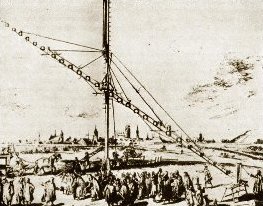
Some early telescope history:
http://brunelleschi.imss.fi.it/telescopiogalileo/
http://galileo.rice.edu/science.html/telescope.html
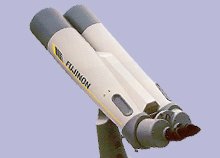
Binocular history:
http://inventors.about.com/library/inventors/bltelescope.htm
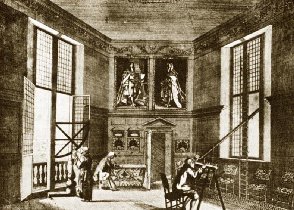
Lots of links related to telescope and binocular history:
http://home.europa.com/~telscope/binotele.htm
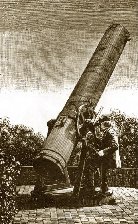
Some historical telescopes:
http://www.space.com/scienceastronomy/celt_telescope_table_000913_MB_.html
http://www.astrosurf.com/re/history_telescope.html
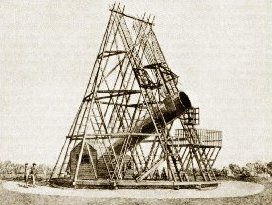
Herschel museum:
http://www.bath-preservation-trust.org.uk/museums/herschel/index.html
http://peterchow.com/photos/United-Kingdom/Bath/Herschel-Museum/
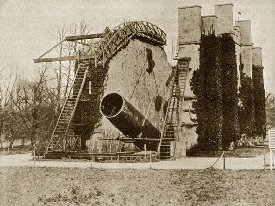
Lord Rosse's Leviathan:
http://www.labbey.com/Telescopes/Parsontown.html
http://www.arm.ac.uk/history/birr6.html
http://www.astrosurf.com/luxorion/univers-rosse.htm
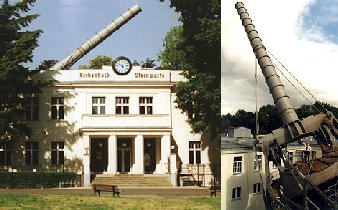
Berlin's Big Refractor - it does not have any dome!
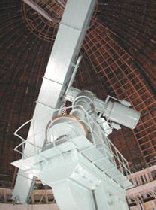
Reparing and renovating "La Grande Lunette" at Meudon, France;
the dome was damaged in a storm 1999 (in French):
http://www.obspm.fr/~unicom/grandelunette/lunette.htm
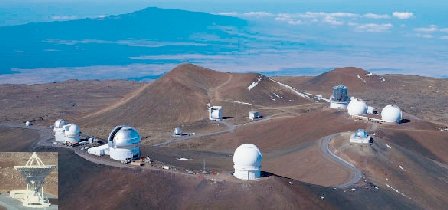
Largest telescopes today:
http://astro.nineplanets.org/bigeyes.html
http://www.wikipedia.org/wiki/List_of_largest_optical_refracting_telescopes
http://www.wikipedia.org/wiki/List_of_largest_optical_reflecting_telescopes
http://en.wikipedia.org/wiki/List_of_largest_optical_telescopes_historically
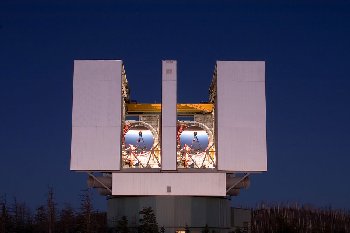
LBT (Large Binocular Telescope) first light in October 2005.
http://medusa.as.arizona.edu/lbto/
Non-web sources:
"The Astronomical Scrapbook", Joseph Ashbrook, Sky Publishing
Corporation 1984, ISBN 0-933346-24-7, out of print for years. "The
Astronomical Scrapbook" was also a monthly column in Sky and
Telescope until 1980. The book contains 91 of the 159 Scrapbooks
columns Joe Ashbrook prepared before his sudden death in August 1980.
"Giant Telescopes of the World", Sky and Telescope, August 2000.
"The History of the Telescope", Henry C. King. First published in 1955 by
Charles Griffin & Company Ltd; republished by Dover Books in 1979 and again in 2003.
The 2003 Dover edition has ISBN 0-486-43265-3 (pbk).
"The Historical Growth of Telescope Aperture", René Racine,
Publications of the Astronomical Society of the Pacific, 116:77-83, January 2004









